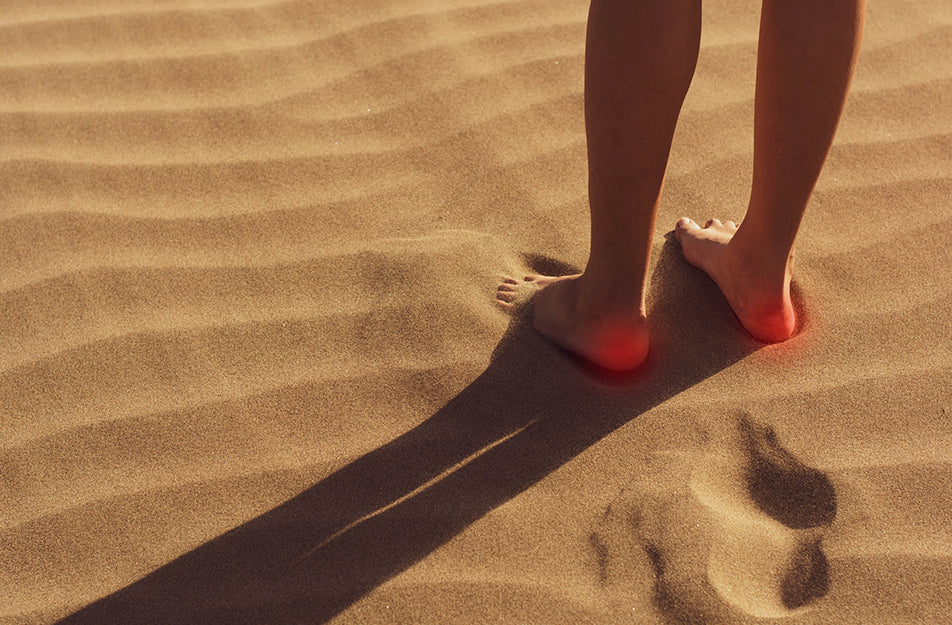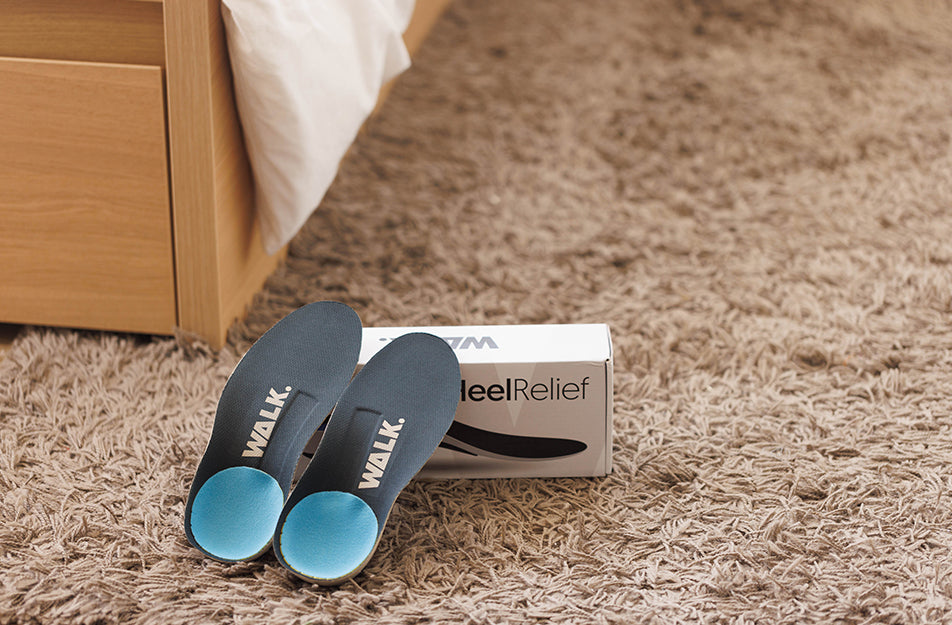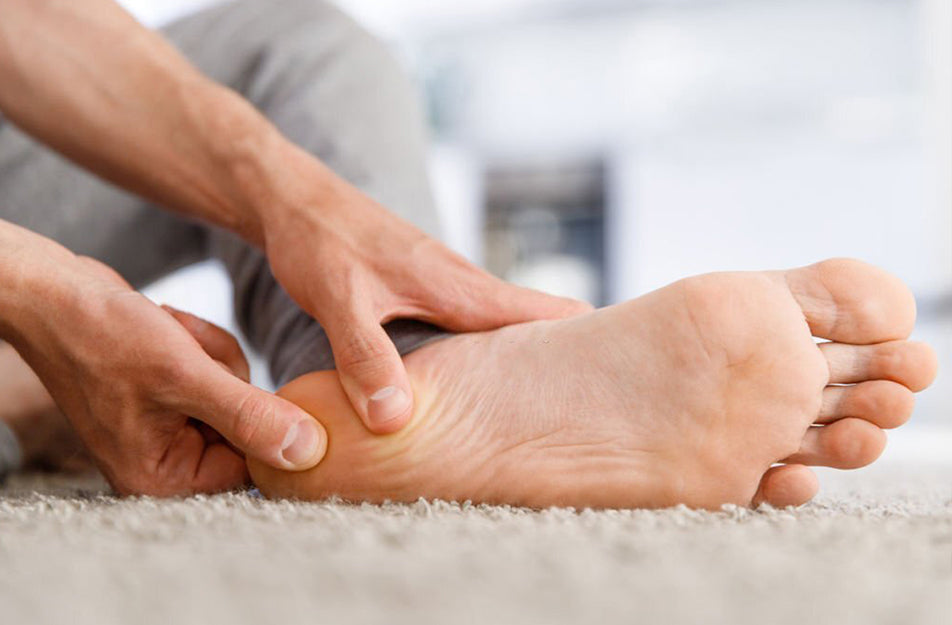What Is a Heel Spur?
A heel spur is an abnormal bony outgrowth that usually forms on the upper or lower part of the heel bone. It develops due to the stress applied over your foot ligaments and can get up to half an inch in length. Most people do not seek help for or realize that they have heel spurs before experiencing the following symptoms:
- Sharp pain in the heel
- Swelling
- Inflammation in the front of the heel
- Small visible bone-like protrusion under the heel
- Tenderness under foot makes it harder to walk barefoot
- Heat radiating from the affected area
However, sometimes, heel spurs cause no symptoms, as a result, they are often only discovered through X-rays, or other tests done for a different foot condition.
What Does a Heel Spur Feel Like?
The sensation of having a heel spur is often described as feeling as if you have stepped on a stone, or sharp knife-like pain in the heel when getting up in the morning. It can turn into a dull ache experienced for the rest of the day. However, not all heel spurs are always painful.
Where Do Heel Spurs Commonly Occur?
Bone spurs are of many types and can form on any bone including your heel. Following are the two most common types of heel spurs:
- Lower Heel Spur: Medically known as the plantar calcaneal spur (PSC), it is a bony outgrowth from the calcaneal tuberosity located on the bottom of your heel. The plantar fascia is a fibrous band of connective tissue present at the bottom of the feet, patients having a common foot condition called plantar fasciitis can often develop these spurs.
- Dorsal/Rear/Achilles Tendonitis Heel Spur: It is a common cause of heel pain and can be classified into insertional and non-insertional types. These are referred to as dorsal heel spurs as they are located on the backside of your heel. Achilles tendonitis spurs are formed in the area where the Achilles tendon inserts into the bone due to the degeneration of the tendons over time. Most patients experience an onset of swelling and pain at the heel bone without any injury, this pain tends to increase over time and becomes noticeable while doing everyday activities.
What Causes Heel Spurs?
Heel spurs form in response to strain or stress applied over your foot's tendons and ligaments. They do not suddenly appear but instead develop over time, and progress further when early symptoms such as inflammation and heel pain are ignored and left untreated. Following are some causes of heel spurs:
- Obesity: Since greater weight bearing can lead to more wear and tear and eventually a spur.
- Arthritis: Swelling of one or more joints can also lead to the development of heel spurs.
- Bruising of the heel: Any kind of trauma caused to the heel can lead to heel spurs.
- Worn-out shoes: It can lead to bruising of your heel which in turn causes heel spurs.
- Running on hard surfaces: It can cause increased stress on your heel leading to spurs.
- Increased age: Due to wear and tear of the plantar fascia and resulting plantar fasciitis, heel spurs are more common in older age.
- Walking gait abnormalities: It causes great stress on the heel bone causing the development of heel spurs.
The chances of getting heel spurs increase with age and are more common in men than in women. Along with these causes, heel spurs also occur due to other medical conditions, for example, plantar fasciitis, ankylosing spondylitis, reactive arthritis (Reiter’s disease), and diffuse idiopathic skeletal hyperostosis.
Do Heel Spurs Go Away on Their Own?
Heel spurs do not go away on their own, and the only way to get rid of a heel spur is through surgery. Though you can reduce the inflammation, pain, and swelling caused by healing spurs with the help of heel spur treatments like cold therapy, exercises, medication, and more.
What Are the Treatment Options for Heel Spurs?
Heel spurs are painful and cause inflammation making it difficult to perform everyday activities. The majority of heel spur treatment options require a lifestyle change to reduce the stress placed on your feet. Following are some treatments that can help you treat heel spurs:
Cold compresses:
Placing ice packs for about 10-15 minutes may help in relieving the pain by temporarily numbing the area. Cold packs are preferred over hot packs while treating pain caused in joints or muscles, as they work better on them.
Anti-inflammatory medication:
Your doctor may recommend anti-inflammatory injections which not only reduce the inflammation but also ease the pain.
Over-the-counter medications:
Medications like ibuprofen (Advil or Motrin), aspirin, and acetaminophen may help in overcoming short or acute pain caused by heel spurs. In addition to this, ibuprofen also helps reduce inflammation as it is an anti-inflammatory drug.
Physical therapy exercises:
You may consult a physical therapist who can guide you through some physical exercises that may help in relieving the pain. These exercises mostly include stretches that can easily be performed at home. Following are some stretches that help in improving heel spur symptoms:
- Calf stretches against the wall
- Seated foot flexes
- Towel grabs with your toes
- Calf stretches on steps
Orthotic shoe inserts:
In addition to proper footwear, orthotic shoe inserts like heel pads help in avoiding heel spurs and provide the support needed by your foot. Orthotic shoe inserts are suitable to provide all-around foot protection.
Using essential oils:
Essential oils are natural anti-inflammatory products that help in reducing swelling and inflammation. But essential oils can also cause side effects like skin irritation, to avoid this, always conduct a patch test before application. Following are some of the anti-inflammatory essential oils:
- Eucalyptus oil
- Rosemary oil
- Thyme oil
- Sesame oil
- Lavender oil
- Fennel oil
Surgery for heel spurs:
Your doctor may recommend surgery if the situation worsens, and the pain becomes unbearable. In this type of surgery, the heel spur is removed which may also involve the releasing of the plantar fascia. These surgeries are not done for heel spurs alone, instead are done when the patient has other foot conditions along with heel spurs. Before recommending the surgery, your doctor will perform an X-rays test to make sure you are a proper candidate for the surgery.
After the surgery, your doctor will recommend you to take rest and avoid putting weight on your foot for some time, along with this, you may be advised to wear a bandage over the incision for up to two weeks. Over-the-counter pain medications can help in minimizing the pain, compression can be achieved by wrapping the bandages tightly. Keeping the affected foot elevated, such that it is slightly above the heart can help in avoiding swelling. Though most patients recover within two weeks, some patients might take up to 3 months to recover.




